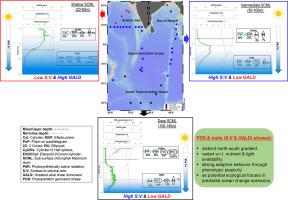Delineating morphological traits of oceanic micro-phytoplankton as potential ecological indicators
IF 8.3
2区 材料科学
Q1 MATERIALS SCIENCE, MULTIDISCIPLINARY
引用次数: 0
Abstract
The micro-phytoplankton (>20 μm) adaptations and resilience were assessed using morphological traits (shape, surface-to-volume ratio; S:V, and greatest-axial-linear-dimension; GALD) from sea-surface and different SCML-depths (shallow:20-50 m, intermediate:50-100 m, and deep:100-140 m) across different bioregions of Indian Ocean. The dominant simple elongated phytoplankton-geometric-shapes (PGSs) and morphological traits showed distinct north-south distribution and varied with light and nutrient availability. Further, SCML and corresponding sea-surface PGS will be similar or dissimilar if the former is located within or deeper than mixed-layer depth. Also, simple and complex PGS contribution gradually decreases and increases with increasing depth. Additionally, shallow SCML-PGS showed low-S:V and high-GALD while vice-versa for intermediate/deep SCML-PGS due to phenotypic plasticity behavior. Overall, only simple-PGS (cylinder, elliptic-prism, and prism-on-parallelogram) showed strong adaptive behavior through phenotypic plasticity and were highlighted as potential ecological tracers to address ecological impact of oceanographic processes (including coastal eutrophication, and aerosol deposition) linked to nutrient and light availability in predicted ocean change scenarios.

划分海洋微浮游植物的形态特征,将其作为潜在的生态指标
利用来自印度洋不同生物区的海面和不同南极海层深度(浅层:20-50米,中层:50-100米,深层:100-140米)的微浮游植物(>20 μm)的形态特征(形状、表面体积比;S:V和最大轴线尺寸;GALD)评估了它们的适应性和恢复力。主要的简单拉长浮游植物几何形状(PGSs)和形态特征呈现出明显的南北分布,并随光照和营养供应而变化。此外,如果 SCML 位于混合层深度以内或比混合层深度更深,则前者与相应的海面 PGS 会相似或不同。此外,随着深度的增加,简单和复杂 PGS 的贡献逐渐减少和增加。此外,由于表型可塑性行为,浅层南极海层-PGS 表现出低 S:V 和高GALD,而中层/深层南极海层-PGS 则相反。总之,只有简单的 PGS(圆柱形、椭圆棱柱形和平行四边形棱柱形)通过表型可塑性表现出很强的适应性,被认为是潜在的生态示踪剂,可用于研究预测的海洋变化情景中与营养和光照可用性相关的海洋过程(包括沿岸富营养化和气溶胶沉积)对生态的影响。
本文章由计算机程序翻译,如有差异,请以英文原文为准。
求助全文
约1分钟内获得全文
求助全文
来源期刊

ACS Applied Materials & Interfaces
工程技术-材料科学:综合
CiteScore
16.00
自引率
6.30%
发文量
4978
审稿时长
1.8 months
期刊介绍:
ACS Applied Materials & Interfaces is a leading interdisciplinary journal that brings together chemists, engineers, physicists, and biologists to explore the development and utilization of newly-discovered materials and interfacial processes for specific applications. Our journal has experienced remarkable growth since its establishment in 2009, both in terms of the number of articles published and the impact of the research showcased. We are proud to foster a truly global community, with the majority of published articles originating from outside the United States, reflecting the rapid growth of applied research worldwide.
 求助内容:
求助内容: 应助结果提醒方式:
应助结果提醒方式:


